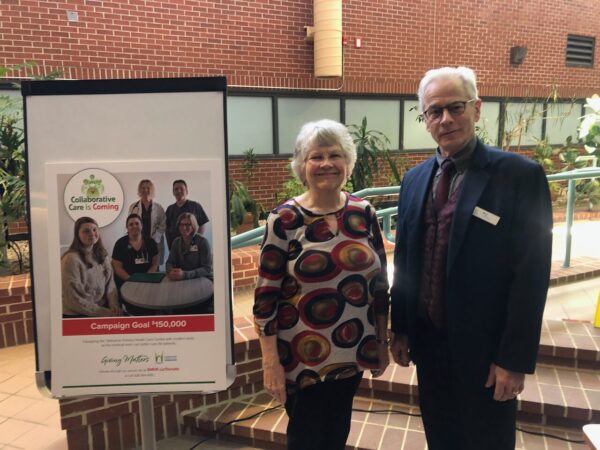“Everything is connected to water,” says Brittany Cormier, executive director of EOS Eco Energy. “And we are as well.”
Every summer since 2019, EOS sends out people into the brooks and streams of the region’s watersheds to observe and record conditions. The teams measures things like pH, temperature, and dissolved oxygen, and they also observe wildlife, plant growth, and check for eutrophication, or excessive algae growth.
But because there’s several watersheds inside EOS territory, these water quality monitoring teams have been working on a rotating basis around the region, one year visiting the Cape Tormentine peninsula, another going to Dorchester and Rockport, and another going to sites in the Tantramar River Watershed.

Cormier says that plan was a good start. “It helped us get a bit more of a snapshot of the local streams and rivers,” says Cormier. But this year, EOS’s water quality team will start a new program. “We just made the decision this year to go forward with an annual water quality monitoring plan,” says Cormier. “We chose 12 sites across those three areas, and we’re going to commit to those.”
It’s one of the recommendations in EOS’s new Integrated Watershed Management Plan for Chignecto Area Watersheds, which it published in February. Committing to fewer sites, but doing monitoring annually, will give a better picture of what’s happening in watersheds from year to year, and it will more quickly build up the ten years of data that’s needed to establish a baseline for the region.
Cormier says there’s a possibility that the new annual EOS program could expand in future to include more sites within the three watersheds, but also points out that EOS’s work is complementary to other monitoring in the region, such as work by Ducks Unlimited and Fort Folly Habitat Recovery.

“Water quality monitoring is very important, province-wide,” says Cormier. “Without it, we don’t know what’s happening in our local streams and rivers.”
The end of an era for the ETF
Monitoring of watersheds in the province of New Brunswick is largely carried out by groups like EOS Eco Energy, with funding from the New Brunswick Environmental Trust Fund (ETF). This year, the ETF funded at least 24 projects from local groups performing local level water monitoring. And every year, groups must apply for project grants, competing for funds to continue their annual monitoring work. It is a time-consuming and uncertain process.
And now there’s increased uncertainty, because the revenue source for the ETF is gone. This year, the province radically changed its beverage container program to give consumers their full deposit back when they return refundable containers. Before April 1, part of that deposit went to the ETF, which is how it grew to have an accumulated surplus of almost $41 million in 2022, according to a critical auditor general’s report that year. But ever since April 1, not a single penny has gone to replenish the fund, which this year dispersed about $9 million to 195 projects in the province.
That surplus is what’s behind a government projection that the ETF will be able to continue without new revenue until 2027, which the government believes is enough time to figure out an alternative.
A spokesperson told CHMA by email that, “the Department of Environment and Local Government is confident that there are sufficient funds to continue investing in environmental priorities until a permanent funding solution is established.”

MLA Megan Mitton would very much like to see a permanent funding solution. Mitton says the ETF needs to continue, but first she’d like to see consultation with people like Cormier, and dozens of others.
“What would be ideal would be for consultations to happen with the environmental non-profits, and have a discussion about what stable long term funding would look like, what kind of programs would make sense?” says Mitton.
She says moving the ETF from its own dedicated revenue source to a government budget line item introduces some risk. “I don’t think there’s a lot of trust that some government might come in and just cut things,” says Mitton. “Relying on the bottle returns was more stable than the political whims of certain politicians, unfortunately. Now, that’s not the case.”
She’d like to see more stable funding, and also funding that acknowledges the long term nature of the work. “We need multi-year funding,” says Mitton. “We know we need watershed monitoring, that should happen every year.”
Mitton proposes a core and project funding model, where reliable funding helps run long term work and “people can apply for more of one-off things.”
Multi-year funding would “take away some barriers,” says Cormier, “and also give us a little bit of security to know that we can continue these projects.” She points across the Northumberland Strait to PEI, where the province has a core funding model for 25 local watershed groups part of the Prince Edward Island Watershed Alliance. “And then for different projects that they need more funding to accomplish, such as restoration, they can apply for that separately,” says Cormier. “So that would be a fantastic model to look at.”
Luckily for Cormier, she’s an optimist, and sees the end of the revenue stream for the ETF as making room for possible improvements to the way the New Brunswick funds watershed monitoring. “I’m banking on that,” says Cormier. “I have rose-coloured glasses, and I hope that this is going to be a turn for the better.”
Hear this story as reported on Tantramar Report:



















